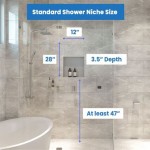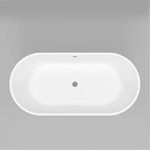Small Bathroom Bathtubs: Maximizing Space Without Sacrificing Comfort
Designing a small bathroom often presents a challenge: fitting essential fixtures into a limited area. Bathtubs, perceived as bulky and space-consuming, are frequently among the first items considered for elimination. However, with thoughtful planning and an understanding of the available options, it is possible to incorporate a bathtub into even the most compact bathroom design without sacrificing comfort or functionality. This article will explore various small bathroom bathtub solutions, offering insights into designs, materials, and installation considerations.
The decision to include a bathtub in a small bathroom is a personal one, often driven by lifestyle preferences. For individuals who enjoy soaking or bathing young children, a bathtub provides a valuable amenity. Before dismissing the possibility, it is crucial to assess the available space accurately and research the diverse range of compact bathtub models designed specifically for small bathrooms. Careful selection and strategic placement can transform a cramped bathroom into a relaxing and functional space.
Understanding Space Constraints and Bathroom Layout
Before exploring specific bathtub options, it is essential to analyze the existing bathroom layout meticulously. Accurate measurements are paramount. This includes the overall dimensions of the bathroom, the placement of existing plumbing, and the location of doors and windows. Creating a detailed floor plan, even a simple sketch, can help visualize different bathtub configurations and identify potential obstacles.
Consider the traffic flow within the bathroom. The placement of the bathtub should not impede movement or make it difficult to access other fixtures, such as the toilet or sink. It is also vital to factor in building codes and regulations related to minimum clearances around plumbing fixtures. Local building codes typically specify minimum distances between fixtures and walls to ensure safety and accessibility.
The shape of the bathroom can significantly impact the choice of bathtub. A square or rectangular bathroom offers more flexibility in terms of layout compared to a long, narrow bathroom. In the latter case, a corner bathtub or a narrow, deep soaking tub might be the most suitable option. Evaluating these spatial considerations early in the design process will prevent costly mistakes and ensure a functional and aesthetically pleasing outcome.
Exploring Small Bathtub Designs and Types
The market offers a wide array of bathtub designs specifically tailored for small bathrooms. Each type presents unique advantages and disadvantages in terms of space utilization, comfort, and aesthetics. Understanding these differences is crucial for making an informed decision.
One popular option is the alcove bathtub. These bathtubs are designed to be installed against three walls, maximizing space efficiency. Alcove bathtubs are often the most affordable option and are readily available in various sizes and materials. However, their standard rectangular shape may not be the most visually appealing for some homeowners.
Corner bathtubs offer a more visually interesting alternative. These bathtubs typically feature a curved or angled front and are designed to fit snugly into a corner. Corner bathtubs can create a focal point in the bathroom and can sometimes offer more bathing space than a standard alcove bathtub. However, they may require more complex plumbing installations.
Another increasingly popular choice is the Japanese soaking tub, also known as an ofuro. These tubs are typically deeper and narrower than traditional bathtubs, allowing bathers to sit upright and immerse themselves in hot water up to their shoulders. Japanese soaking tubs are ideal for small bathrooms where space is at a premium. They offer a luxurious bathing experience while taking up minimal floor space.
Finally, consider the walk-in bathtub. While often associated with accessibility for individuals with mobility issues, walk-in bathtubs can also be a suitable option for small bathrooms. These bathtubs feature a watertight door that allows bathers to enter and exit the tub easily. Walk-in bathtubs are typically taller than standard bathtubs, but their compact footprint can make them a viable choice for smaller spaces.
Material Considerations and Installation Requirements
The material of the bathtub can significantly impact its durability, weight, and heat retention. Several materials are commonly used in bathtub construction, each with its own set of advantages and disadvantages.
Acrylic bathtubs are a popular choice due to their lightweight construction, affordability, and excellent heat retention. Acrylic is a non-porous material that is resistant to stains and scratches. Acrylic bathtubs are also relatively easy to repair if damaged. However, they may not be as durable as some other materials and can be prone to fading over time.
Cast iron bathtubs are known for their exceptional durability and heat retention. Cast iron is a heavy and robust material that can withstand years of use. Cast iron bathtubs are typically coated with a layer of enamel to protect the underlying iron and provide a smooth, glossy finish. However, cast iron bathtubs are significantly heavier than acrylic bathtubs and can require additional floor reinforcement.
Steel bathtubs offer a compromise between the lightweight construction of acrylic and the durability of cast iron. Steel bathtubs are typically coated with porcelain or enamel to provide a smooth, water-resistant surface. Steel bathtubs are less expensive than cast iron bathtubs but may not retain heat as well. They can also be prone to chipping if not properly cared for.
Installation requirements for small bathroom bathtubs vary depending on the type of bathtub and the existing plumbing configuration. It is crucial to consult with a qualified plumber to ensure that the installation is done correctly and meets all local building codes. Proper drainage is essential to prevent water damage and mold growth. The plumber will also need to ensure that the water supply lines are properly connected and that the bathtub is adequately supported. For heavier bathtubs, such as cast iron models, floor reinforcement may be necessary to prevent structural damage.
Beyond the technical aspects of installation, consider the aesthetics of the surrounding bathroom. Coordinate the style and color of the bathtub with the existing fixtures and décor. A well-chosen bathtub can enhance the overall look and feel of a small bathroom, creating a relaxing and inviting space.
Optimizing Space with Smart Storage Solutions
Incorporating smart storage solutions around the bathtub is crucial for maximizing space in a small bathroom. Clutter can quickly make a small bathroom feel even smaller. Strategic storage can help keep bath essentials organized and out of sight, creating a more streamlined and functional space.
Consider installing recessed shelving in the wall surrounding the bathtub. Recessed shelving provides ample storage space without encroaching on valuable floor space. These shelves can be used to store shampoo bottles, soap, and other bath products. Choose shelves that are made of water-resistant materials, such as glass or tile, to prevent damage from moisture.
Another option is to install a bathtub caddy. These caddies are designed to hang over the side of the bathtub and provide convenient storage for bath essentials. Bathtub caddies are available in a variety of materials and styles to suit different tastes and bathroom décor. Look for caddies that are adjustable to fit different bathtub sizes.
Under-sink storage is another valuable resource in a small bathroom. Install a vanity with drawers or cabinets to store towels, cleaning supplies, and other items. Consider using drawer organizers to maximize the use of space within the vanity. A well-organized vanity can significantly reduce clutter in the bathroom.
Finally, consider using vertical space to your advantage. Install shelves or cabinets above the toilet or above the bathtub to store items that are not frequently used. Use decorative baskets or containers to store items on shelves to keep them organized and visually appealing. Utilizing vertical space can dramatically increase storage capacity in a small bathroom.
Lighting and Ventilation Considerations
Proper lighting and ventilation are essential for creating a comfortable and functional bathroom, especially in small spaces. Poor lighting can make a bathroom feel cramped and dingy, while inadequate ventilation can lead to moisture buildup and mold growth.
Maximize natural light by keeping windows clean and unobstructed. If privacy is a concern, consider using window treatments that allow light to filter through while still providing privacy. Sheer curtains or frosted glass windows can be effective solutions.
Supplement natural light with artificial lighting. Install a combination of ambient lighting, task lighting, and accent lighting to create a well-lit bathroom. Ambient lighting provides overall illumination, while task lighting is focused on specific areas, such as the vanity or shower. Accent lighting can be used to highlight architectural features or decorative elements.
Ensure adequate ventilation by installing an exhaust fan. The exhaust fan should be sized appropriately for the size of the bathroom to effectively remove moisture and odors. The fan should be vented to the outside of the house to prevent moisture from accumulating in the attic or walls. Consider installing a timer or humidity sensor to automatically turn on the exhaust fan when humidity levels are high.
In addition to an exhaust fan, consider using other strategies to improve ventilation, such as opening windows after showering or bathing. This will help to circulate air and prevent moisture buildup. Regularly clean bathroom surfaces to remove mold and mildew.
By carefully considering lighting and ventilation, it is possible to create a bright, airy, and healthy bathroom environment, even in a small space. Proper lighting and ventilation will not only improve the functionality of the bathroom but also enhance its overall aesthetic appeal.

Beautiful Small Bathtubs That Will Make You Fall In Love Maison Valentina Blog

10 Small Bathroom Ideas With Bathtubs You Will Love

7 Stand Alone Bathtubs For Small Bathrooms Luxury Freestanding Tubs

12 Bathtubs For Small Spaces 2024 Badeloft

Trend Alert 8 Narrow Bathrooms That Rock Tubs In The Shower Rubenstein Supply Company

Small Bathroom Ideas With Bathtubs

10 Small Bathroom Ideas With Bathtubs You Will Love

Tub Shower Combo For Small Bathrooms Improveit

Walk In Bathtub Options For Small Bathrooms American Tubs

12 Bathtubs For Small Spaces 2024 Badeloft








